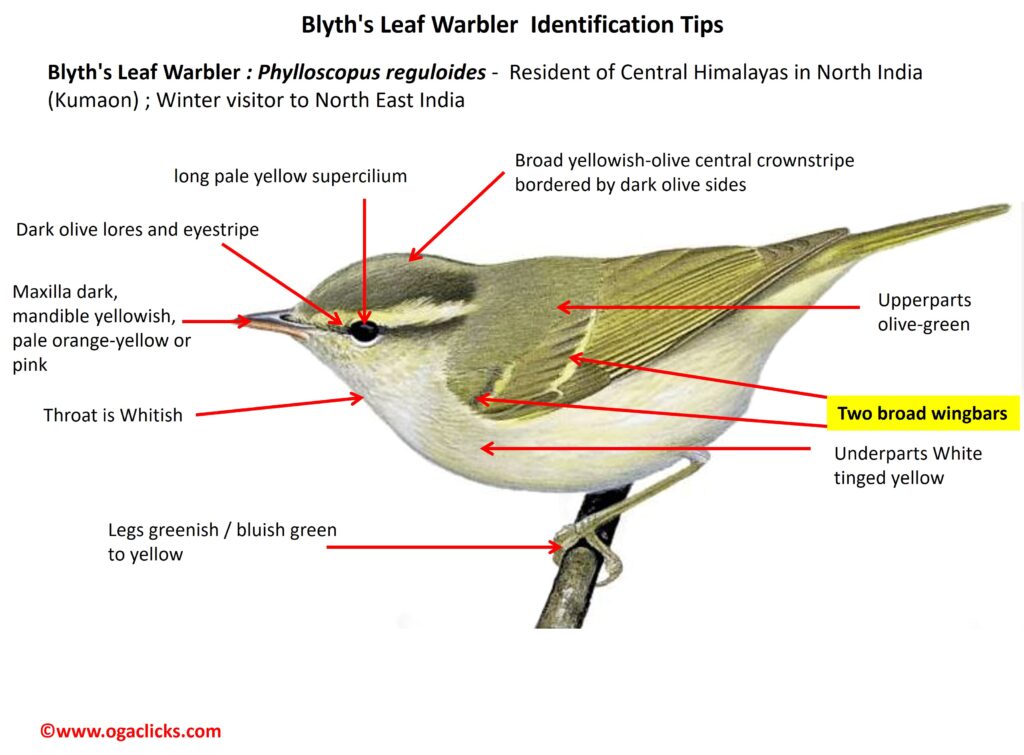
Blyth’s Leaf Warbler Phylloscopus reguloides
Etymology:
- Phylloscopus : Greek word phullon – leaf; skopos – seeker
- Reguloides: Latin word for “ royal, regal” derived from regius- royal : greek word oides– resembling
Vernacular name : Mar: Blythcha Parnavatvatya
Sub species:
- Nominate- Resident of Central Himalayas in North India (Kumaon) ; Winter visitor to North East India
- r. kashmiriensis– Resident of North West Himalayas from Kashmir Eastwards to North India (Simla Eastwards to Garhwal); winter visitor to foothills.{Upperparts yellower, crown-sides not so dark, underparts whiter}
- r. assamensis– Resident of East Himalayas of North East India (Arunachal Pradesh, Assam, Manipur) ; Winter visitor to Sikkim{Darker upperparts, often slightly more white in outer tail feathers}
Distribution :
- Nominate- Resident of Central Himalayas in North India (Kumaon) ; Winter visitor to North East India
- r. kashmiriensis– Resident of North West Himalayas from Kashmir Eastwards to North India (Simla Eastwards to Garhwal); winter visitor to foothills.
- r. assamensis– Resident of East Himalayas of North East India (Arunachal Pradesh, Assam, Manipur) ; Winter visitor to Sikkim
Description : Its size is 10·5–12 cm; wt is 6·2–9·4 g. It is a medium-sized, well-marked leaf-warbler. The nominate race has long pale yellow supercilium, dark olive lores and eyestripe; broad yellowish-olive central crownstripe, rather indistinct anteriorly, bordered by dark olive sides of crown, which become blacker posteriorly. The upperparts are olive-green, median and greater upperwing-coverts are tipped yellow forming two broad wingbars. The flight-feathers and tail feathers are dark brown, inner webs of outer two rectrices narrowly edged white. The throat and underparts are whitish, tinged yellow, becoming pale yellow on undertail-coverts. The axillaries are bright yellow; iris is dark brown; maxilla is dark, mandible is yellowish, pale orange-yellow or pink. The legs are variable, from greenish or bluish green to yellow. Both the sexes are alike. Juvenile is like adult, but has plainer crown, browner upperparts, only faint median coverts wingbar, duller underparts. Race kashmiriensis is very like nominate and doubtfully distinct, though claimed to have upperparts yellower, crown-sides not so dark, underparts whiter; assamensis has darker upperparts, often slightly more white in outer tail feathers, although this is variable; ticehursti has yellower supercilium, crownstripe, wingbars and underparts, and slightly greener upperparts.
Habitat : It is found in rhododendron and oak forests, also locally in conifer and moist deciduous forest. It is found in between 1500 m and 3700 m; in non-breeding season, at lower levels below 1500 m in evergreen forest edges, secondary forest, clearings, scrub and bushes in foothills, also edges of cultivation.
Food habits : It eats small arthropods and larvae; small berries occasionally taken in autumn. It feeds in upper levels of tall trees and low down in bushes; occasionally clings to tree trunks in manner of nuthatch and hangs upside-down to feed under branches. It has a habit of slowly flicking wings alternately when agitated. It forages alone or in pairs; in non-breeding season often in mixed-species flocks
Breeding habits : They breed in Feb–Aug. The nest is built by both sexes. The nest is a ball of grasses, stems and other material, placed in hole in tree stump, on ground under tree roots, in bank or in stone wall. They lay a clutch of 4–5 eggs. The incubation is done by female. Nest is parasitized by Oriental Cuckoo and Lesser Cuckoo.